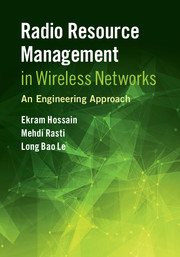Book contents
- Frontmatter
- Contents
- Preface
- Part I Basics of Wireless Networks
- Part II Techniques for Modeling and Analysis of Radio Resource Allocation Methods in Wireless Networks
- Part III Physical Layer Resource Allocation in Wireless Networks
- Part IV Link Layer Resource Allocation in Wireless Networks
- 10 Sub-Carrier/Sub-Channel Allocation in OFDMA Networks
- 11 Resource Allocation in Relay-Based Networks
- 12 Channel Allocation for Infrastructure-Based 802.11 WLANs
- Part V Cross-Layer Modeling for Resource Allocation in Wireless Networks
- Index
- References
10 - Sub-Carrier/Sub-Channel Allocation in OFDMA Networks
from Part IV - Link Layer Resource Allocation in Wireless Networks
Published online by Cambridge University Press: 11 May 2017
- Frontmatter
- Contents
- Preface
- Part I Basics of Wireless Networks
- Part II Techniques for Modeling and Analysis of Radio Resource Allocation Methods in Wireless Networks
- Part III Physical Layer Resource Allocation in Wireless Networks
- Part IV Link Layer Resource Allocation in Wireless Networks
- 10 Sub-Carrier/Sub-Channel Allocation in OFDMA Networks
- 11 Resource Allocation in Relay-Based Networks
- 12 Channel Allocation for Infrastructure-Based 802.11 WLANs
- Part V Cross-Layer Modeling for Resource Allocation in Wireless Networks
- Index
- References
Summary
Introduction
OFDM has become the multicarrier transmission technique of choice in broadband transmission over wireless channels. This has been adopted for several wireless access technologies including IEEE 802.11a/g, IEEE 802.16, Digital Video Broadcasting (DVB), and Digital Audio Broadcasting (DAB). What makes OFDM an interesting choice for next generation broadband wireless transmission is its ability in combating frequency selective fading. Instead of transmitting digital symbols sequentially over a single wideband channel, OFDM divides the channel into many narrowband sub-channels or sub-carriers and then simultaneously transmits digital symbols in parallel over these sub-carriers. A transmitted digital symbol over a sub-carrier then experiences a flat fading channel.
In a multiuser scenario, a particular sub-carrier at a particular instant may appear differently, in terms of fading characteristics, to different users due to the varying nature of wireless channels and users’ locations. This provides an opportunity to assign certain sub-carriers to users who can utilize them best at that particular moment. The resulting mechanism of such sub-carrier allocation can be viewed as an OFDM-based multiple access scheme called Orthogonal Frequency Division Multiple Access (OFDMA) in which each user is assigned a subset of sub-carriers for exclusive use at any given time. In assigning sub-carriers to users, other resources such as power and modulation format also can be allocated to each assigned sub-carrier. As the number of users increases, there will be more freedom in allocating sub-carriers, transmission power, and modulation format per sub-carrier to different users. To tailor the OFDMA system to users’ needs in terms of desired data rate, maximum available transmission power, or utility, it is natural then to devise a resource allocation scheme that adapts to users’ varying channel conditions on a temporal basis. Adaptive radio resource allocation is thus essential to the performance of OFDMA systems. In recent years, many researchers have tried to explore this idea of adaptively assigning radio resources to users in OFDMA systems in order to optimize a certain metric of interest such as data rate, transmission power, and utility subject to certain constraints.
- Type
- Chapter
- Information
- Radio Resource Management in Wireless NetworksAn Engineering Approach, pp. 291 - 307Publisher: Cambridge University PressPrint publication year: 2017



